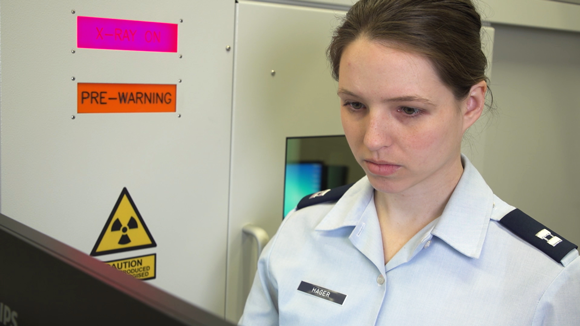Research project finds AM AF-9628 parts stronger than conventional AM alloys
September 3, 2019

The Air Force Institute of Technology (AFIT), located at Wright-Patterson Air Force Base, Ohio, USA, reports that Capt Erin Hager, a graduate of its Aerospace Engineering Program and an Air Force Research Laboratory (AFRL) employee, recently conducted a research project which found that additively manufactured AF-9628 parts are approximately 20% stronger than parts produced from conventional AM alloys.
AF-9628 is an Air Force steel alloy developed by AFRL’s Dr Rachel Abrahams, which offers high strength and toughness. The formula to produce the alloy reportedly costs less than other high performance steel alloys, including Eglin Steel and HP-9-4-20, but is more expensive than common grades used in conventional munitions. It does not contain tungsten, like Eglin Steel, or cobalt, part of the formula for HP-9-4-20.
Sponsored by the Air Force Research Laboratory Munitions Directorate at Eglin AFB, Valparaiso, Florida, USA, Hager’s research found that AF-9628 is an optimal material for Additive Manufacturing due to its high strength. AFIT explained that, while these findings are comparable to values reported in a similar U.S. Army Combat Capabilities Development Command Army Research Laboratory study, Hager’s study yielded similar mechanical properties to conventionally forged and heat treated AF-9628.
Hager produced test parts from AF-9628 steel using Laser Powder Bed Fusion (L-PBF). “To determine if AF-9628 was printable, we characterised the shape and size of the powder and [identified] how it changed with melting and sieving,” she stated.
She then examined the steel under a scanning electron microscope (SEM) at AFIT and performed tests at the University of Dayton Research Institute using a size characterising light microscope. After producing various parts, she analysed the resulting porosity, strength and impact toughness.
Upon examination, Hager determined that the parts matched the required 10% elongation, indicating increased strength without becoming brittle. She went on to additively manufacture complex designs using two L-PBF machines at AFIT and produced appoximately 130 articles.
Currently, the AF-9628 powder is only available in small production quantities and companies can take months to formulate it. As such, while AF-9628 is a less expensive steel, Hager explained that the powder form is not currently cost-effective to acquire since the demand is low.
Hager stated that she hopes that the Air Force will “take this high strength steel and come up with some new applications that we haven’t even thought of yet.” She recently presented her research during an international Powder Metallurgy conference and at an ordnance and ballistics symposium.
















